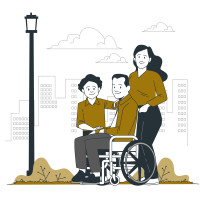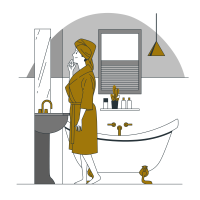Domus Aurea
 Domus Aurea
Domus Aurea
Domus Aurea literally means "The Golden House" because of the considerable amount of gold used in its construction. It was an urban villa built by Emperor Nero after a great fire ravaged Rome in 64 AD. Much of the central city was destroyed, giving the princeps the opportunity to acquire about 80 hectares of land for the construction of a palace, spread over the Palatine, Esquiline and Caelian hills.
The house, which was probably never completed, was demolished after Nero's death when the land on which it stood was returned to the people of Rome. What remains of the Domus Aurea lies beneath what later became the Baths of Trajan, and together with the whole of the historic centre of Rome, the extraterritorial properties of the Holy See in Italy, and the Basilica of St Paul Outside the Walls, were inscribed on the UNESCO World Heritage List in 1980. After the great fire of 64 AD, which destroyed much of the centre of Rome, Nero began to build a new house. Known to history as the Domus Aurea, it is remembered for its wealth and splendour.
The palace was designed by the architects Severus and Celer and decorated by the painter Fabullus. The house was actually a group of buildings surrounded by gardens, woods, vineyards and an artificial lake in a valley where the Colosseum now stands. The main parts were located on the Palatine Hill and the Oppian Hill, and were famous for their rich decorations of stucco, paintings, coloured marble, gold and precious stones. There were many comforts within this large group such as baths with normal and sulphurous water, several dining rooms one of which was the famous Coenatio rotunda that moved plus a large entrance hall where stood the giant statue of the king as if he was the sun god.
 Nero at Baiae by Jan Styka
Nero at Baiae by Jan Styka
After Nero's death
After the death of Nero, successive emperors "gave back to the Roman people" the land on which Domus Aurea stood. This did not happen immediately because of its unpopularity and also because of the underlying ideology. In fact, as Suetonius reports, Otho was the only emperor to complete the Domus Aurea, which cost a great deal of money - 50 million sesterces. Vitellius, for his part, only condemned the building as unsightly and austere; he later decided to live there when he fell ill. During Vespasian's reign, the Domus began to be levelled. For almost ten years, all the rich trappings of Nero's house were stripped away.
Vespasian used the same place where the artificial lake had once been, drained its waters and dried up the land, and demolished the buildings that ran from the Vestibulum to the Stagnum, filling them with rubbish in order to raise the ground for the construction of the Flavian Amphitheatre. He demolished the Nymphaeum on the Caelian Hill and completed the temple dedicated to the divine Claudius by Agrippina Minor.
Vespasian altered the base of the Domus Tiberiana to accommodate a thermal building, while transforming the central peristyle into an apsidal hall between two side porticoes. Work on the Baths of Titus began in 79, while his younger son built a new house for the king on the Palatine Hill, inaugurated in 92. Nero's houses were demolished and this one took their place, using their walls.
 Domus Aurea - Achille Sciro Hall
Domus Aurea - Achille Sciro Hall
Modern and contemporary
At the end of the 15th century, a young man fell into a hole in the slope of the Oppio. He found himself at the bottom of a strange, richly painted cave. Soon after the discovery, ropes were used to support planks with artists on one side, so that they could dangle over the frescoes to have a good look at them. The silly and almost washed-out frescoes that now protrude from the wall had an enormous impact on the whole Renaissance.
When Pinturicchio, Raphael and Michelangelo went underground to look at them, they learned something quite startling about antiquity. Besides the autographs of some famous guests, placed not too far from each other on the walls - Giacomo Casanova and the Marquis de Sade - we also find Domenico Ghirlandaio, Martin van Heemskerck and Filippino Lippi. The impact was immediate and enormous for the artists of the time, as can be seen in the ornamentation of Raffaello in the Vatican logge durantanthe Renaissance. Because one bath was mistaken for another, especially since it was located between the Baths of Trajan and Titus, the Domus dell'Oppio was called the Palazza di Tito.
Moisture had already seeped into the rooms and a process of decay had begun, a process that time could not stop. The last part to fall from the ceiling was due to the rain. After many years, the site is now open, but the risks posed by traffic, the roots of the garden trees and other problems that affect this area have not been eliminated; this does not stop the excavation and exploration of this site. In May 2019, restoration work was being carried out in the Colosseum Archaeological Park when, by chance, a never-before-explored chamber was discovered. This vaulted chamber rises to a height of 4.5 metres and is incredibly well preserved in its frescoed walls depicting the deities Pan, Panthers and a Sphinx, hence the name Sala della Sfinge.
 Domus Aurea - Volte
Domus Aurea - Volte
Description of the Domus Aurea
The Domus Aurea seems to have been modelled on the seaside houses of Campania, with loosely arranged buildings in a setting that allowed magnificent views of the sea through gardens, terraces and porticoes. Baia, in particular, seems to have inspired them. This was the most famous residential area in the whole of the Roman Empire, with numerous luxurious villas, thermal baths and places of entertainment. Nero's house, in fact situated like a villa overlooking an "artificial" sea (the Stagnum), as noted by Carandini, was in fact one of those places of elite pleasure where feasts were held on pleasure boats (cumbae).
If one compares a villa in Baiae with the pavilion in Oppio, there is a striking resemblance [right around the xystus found in the southern part]. The landscaping, mainly of lawns, fields, vineyards, woods, waters and the erection of domus, pavilions and nymphaea, was designed by the architects Severo and Celere, under the very close supervision of Nero, who, through the creativity and boldness of their work, created with art what nature had not provided.” Indeed, the domus was essentially a landscaping project. The house covered the sides of the Palatine, Velia and Oppio hills and part of the Esquiline up to the Horti Maecenatis.
The horti are not part of the main body of the domus; they form an annex left by Augustus after the death of Maecenas. It also included the north-western part of the Caelian Hill, aligned with the podium of that temple, which was later developed into a nymphaeum dedicated to the divine Claudius. Where the Flavian amphitheatre now stands, there is an area between these hills that was the centre of the villa. The way to the main door of the house was from the Roman Forum, next to the Atrium Vestae. People entered through a large vestibule, which was clearly marked by a huge statue of Nero placed on the vestibule (known as the Colossus). In his account of the house,
Suetonius goes on to say: "The decorations were made of gold, precious stones and mother-of-pearl. He built dining rooms with ceilings of movable, perforated ivory panels so that he could shower his guests with flowers and perfumes. The main one was round and turned continuously, day and night, imitating the movement of the earth. There were baths at hand, from which flowed sea water and albule."
 Colosso di Nerone
Colosso di Nerone
Vestibule and Colossus of Nero
Around the Domus Aurea was a portico which, according to Suetonius, had three rows of columns for a mile (1,482 metres). To the east was the vestibulum or entrance courtyard, which extended from the Clivus Palatinus at the top of Velia. This was the main entrance to the Domus Aurea complex, which could be approached from the direction of the Roman Forum.
Nero ordered the making of a huge bronze statue called the Colossus Neronis, which stood at a height of 119-120 feet (about 35 metres) and depicted him in the garb of the Roman sun god Apollo. This great statue stood in the centre of the vestibulum. According to Pliny the Elder, it was made by Zenodorus, a Greek sculptor. Probably inspired by the Colossus of Rhodes, the bronze depicts Nero as the sun god. His right arm is outstretched, first on a club—in the time of Commodus—later on a rudder. His left arm is bent to hold a globe. It wears a crown of seven rays, each 6 metres long.
This is recorded on the coins of Alexander Severus and Gordian III. The giant statue then came to bear the heads of various successive emperors, or was meant to be the sun god in the time of Vespasian, and Hercules under Commodus. But Hadrian later moved the statue to fit in with the construction of the Temple of Venus and Rome. Then the vestibulum was demolished. The statue was probably destroyed during the first Gothic invasions around 410 AD. It remained in the collective memory throughout the Middle Ages, so much so that it gave its name to the adjacent Flavian Amphitheatre. In 1933, the brick foundation built by Hadrian to move the statue from the Vestibulum was finally demolished.
 Domus Aurea - Ricostruzione ipotetica sul colle Oppio
Domus Aurea - Ricostruzione ipotetica sul colle Oppio
 Domus Aurea (il corpo sul colle Oppio)
Domus Aurea (il corpo sul colle Oppio)
Domus Aurea (the body on the Oppio hill)
This part of the house stood on the Oppio. It had a separate wing, later covered by Trajan's Baths, which can still be seen today. This was the private area. Carandini gives his view of how the famous line from Suetonius about this pavilion should be understood:
- It had gold, precious stones and mother-of-pearl;
- Included dining rooms (cenationes) with ceilings and ivory furniture that opened to throw flowers on the guests;
- Contained a main banquet hall (cenatio principalis), which was round (rotunda) and seemed to move eternally like the cosmos, as Carandini places it in the house between the entrance and the pond on which it overlooked;
- Finally, there were baths with both ordinary and sulphurous water.
This domus, built of brick and stone in the years after the fire and before Nero's death in 68, was famous not only for its rich cast gold decorations, which gave it its name, but also for its stucco ceilings decorated with semi-precious stones and ivory plates. The construction of this great house was witnessed by Pliny the Elder.
Beneath the later Baths of Trajan on the Oppian Hill, what has come down to us is essentially a villa for entertainment, consisting of 300 rooms with no bedrooms, kitchens or latrines - none of which have been discovered. The rooms, made of highly polished marble, presented complicated dispositions and arrangements in niches and exedra, at the same time concentrating and dispersing the light of the sun. There were also swimming pools on different floors and fountains in the corridors.
Services and Accessibility

Wheelchair accessible

Toilets

